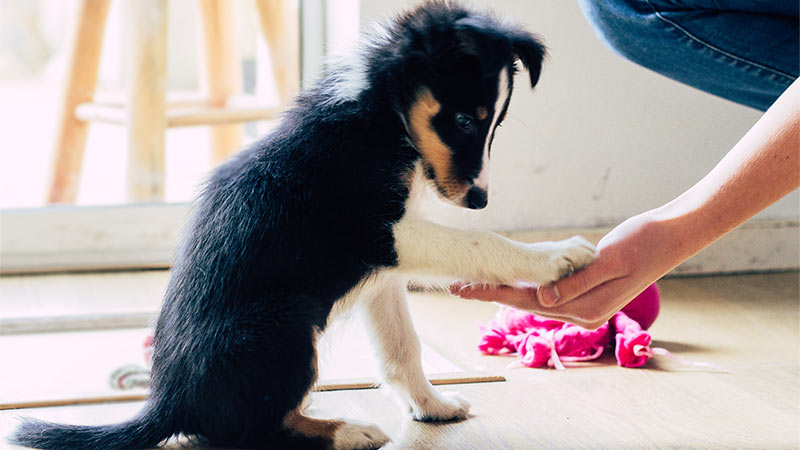My dear friend almost lost her sweet miniature schnauzer to parvo. After spending several days in the emergency vet, Ace, a trooper of a puppy, finally got to return to his family, where they watched him like a hawk, determined not to let him get into trouble in their yard. They think their yard, frequented by many animals, is where he picked up the potentially deadly disease.
The importance of puppy training
We cannot protect our pets from everything, but we can teach them certain cues that will set them up for success. My friend may not have been able to keep her dog from getting into another animal’s feces, but she has been working with him on the cue, “leave it,” to encourage him to ignore dropped items or materials on the ground that she doesn’t want him to have.
“Leave it,” can be a valuable cue for a puppy to learn when it comes to hazards such as a dropped chicken bone in the kitchen or spilled medication in the bathroom. On walks, obeying the cue, “leave it,” can keep a puppy from sniffing feces that could be infected with a disease he has not been vaccinated against. Your dog should look to you for permission before eating anything off the ground, but this can be a lot to ask of a puppy. That is why training your puppy in the comfort and quiet of your home is so important.
Prepare your puppy
National Puppy Day was established in 2006 by Colleen Paige, who wanted to celebrate the joys of puppyhood and also raise awareness about puppy mills and encourage adoption. In honor of National Puppy Day on March 23, let’s highlight five basic cues all puppies should know. Through positive reinforcement and training sessions that are fun (and short enough for a puppy’s limited attention span) you can prepare your puppy for a long, happy life.
- Come. The most important thing to remember when teaching your dog to come when called is that coming to you should be fun! Reward your dog with a treat and/or lots of praise every time he comes to you when called. Never call your dog to scold him as that can be confusing to your dog. Also, avoid repeating your dog’s name when you want him to come to you. Simply give the command, and reward when he follows through.
- Sit. According to Sarah Westcott, “sit” is the most essential cue to teach your dog. Westcott, CPDT-KSA, and owner of Doggie Academy in New York, says this command is especially important when you have guests at your house. Sitting helps curb jumping up, inappropriate chewing, biting, and barking. It is also a relatively easy command to teach your dog using a small treat as a “lure,” and rewarding your dog only when his bottom touches the ground. Once your dog has this command mastered, you can use it to keep him from excitedly knocking down your company as they walk in the door!
- Loose-leash walking. Leash walking is an important skill, but teaching a puppy leash manners can be one of the most trying aspects of training. Puppies are usually more interested in chewing on their leash or chasing after any interesting debris they can find on the sidewalk. However, they still need their exercise, and they need to learn to walk without pulling. Decide which side you would like your pup to walk on and then choose a cue such as “let’s go” or “forward” to let your puppy know it is time to walk. Be consistent with that cue and always use the same word. It is up to you which side your puppy walks on, but being consistent will keep him from zig-zagging in front of you.
- Leave it. It can be helpful to teach your dog when it IS ok to accept a treat or eat a meal by teaching him the cue, “release,” or “ok,” first. When we feed our dog, she knows to wait until we say “ok” to eat. Once your dog is proficient in waiting for the cue “ok,” you can move on to teach “leave it.” The “leave it” command means to leave a certain object alone--do not pick it up, smell it or look at it! See our post, Teach Your Dog the Leave It Command, for more on this important cue.
- Stay. Perhaps the most lifesaving of the five! A dog who knows the cue, stay, will not run out of the house into a busy street. Here is where teaching your dog a release word, like “OK,” or “free,” can come in handy again. A puppy who knows the “stay” cue will remain sitting until you ask him to get up by giving another cue, or the release word.
By teaching your dog these cues, you can make sure your puppy is well-equipped for this adventure called life! You're not only keeping your puppy safe, but also making sure he knows what is expected, and is rewarded when following through. Every dog wants to be a good dog, but we can’t expect them to know what they don’t know!
Keep your dog healthy and safe
For more on how to teach these cues, see our post, Essential Cues to Teach Your Dog. If National Puppy Month has you checking local shelters for an adorable addition to your family or looking up ways to keep your current four-legged family member safer, make sure you consider enrolling your pup in a pet insurance policy. Pet insurance can help protect you against unexpected veterinary bills for accidents and illnesses. You can also enroll in wellness coverage which will reimburse for preventative care items such as vaccinations/titers, dental cleanings, and much more! Get a quote today and start protecting your pup so you can celebrate many more National Puppy Days together!

